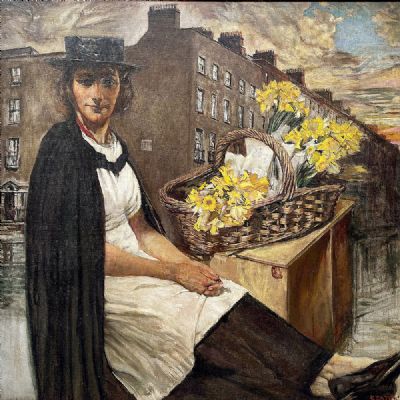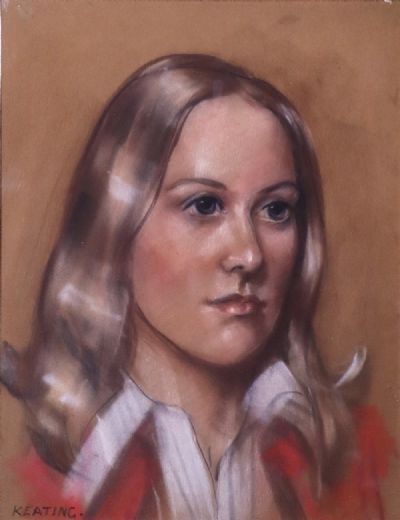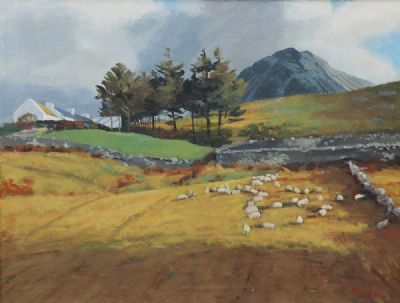Bidding on this item has ended.
Sean Keating
ELIZA DOOLITTLE IN DUBLIN
Lot 27
Result:
Not Sold
Estimate:
€50,000 - €70,000
Sean Keating PPRHA, HRA, HRSA, 1889-1977
ELIZA DOOLITTLE IN DUBLIN (1965)
Oil on canvas board, 43" x 43" (109.2 x 109.2cm), signed; inscribed on label verso.
Provenance: Provenance: Acquired directly from the artist by the family of the ...
Read more
 Lot 27
Sean Keating
ELIZA DOOLITTLE IN DUBLIN
Lot 27
Sean Keating
ELIZA DOOLITTLE IN DUBLIN
 Lot 27
Sean Keating
ELIZA DOOLITTLE IN DUBLIN
Lot 27
Sean Keating
ELIZA DOOLITTLE IN DUBLIN
Estimate:
€50,000 - €70,000
Sean Keating PPRHA, HRA, HRSA, 1889-1977
ELIZA DOOLITTLE IN DUBLIN (1965)
Oil on canvas board, 43" x 43" (109.2 x 109.2cm), signed; inscribed on label verso.
Provenance: Provenance: Acquired directly from the artist by the family of the current owner.
Exhibited in The Bell Gallery, Belfast, 1965.
Eliza is a self-assured flower seller, confident on her temporary throne at the edge of a street in Dublin. Her daffodils, symbolic of rebirth and hope, reveal the time of year, and yet the streetscape behind her is cast into shadow under the thunderous clouds and setting sun. Dressed as if on stage, Eliza's costume recalls another age, yet her scenery is recognisable by virtue of the original street sign on the wall to the right of her shoulder.
Along with so many others, some of whom founded the Irish Georgian Society and the Dublin Civic Group, Sean Keating was vociferous in his condemnation of the destruction of Georgian Dublin that began in the 1950s.[1] The 'next move' he said, would be 'to feed the books in the library of Trinity College to the boilers of the Pigeon House.' [2] Painted in 1965, Eliza Doolittle in Dublin, alludes to plans to demolish several Georgian buildings on Hume Street and St Stephen's Green to make way for modern office accommodation. Opposition to the proposal went on until 1969 when the Minister for Local Government gave the go-ahead for the demolition, which lead to the occupation of the buildings. On Sunday 7 June, 1969, the occupiers were removed by force in an action that became known as the 'battle of Hume Street.' Keating's son, Justin, by then a Labour TD, who was among the large crowd of protestors that gathered in support of the occupiers that day in June, echoed the feelings of many when he said:
'Large areas of Georgian Dublin are looked on by people all over the world as being not just a treasure to the Irish people but as a treasure to world architecture. It may be that because we associate them with the past, with landlords and so on [that] we hate the Georgian idea and wish to wipe it out of our consciousness by destroying the buildings… We will build the future of this country by recognising the validity of every strand in our national culture. Our Georgian architecture is one of our most valuable possessions.'[3]
Keating's Eliza Doolittle in Dublin deliberately referenced the flower seller in Dublin-born George Bernard Shaw's Pygmalion, whom Professor Higgins unsuccessfully tried change into his vision of someone else. Keating's dignified Eliza, unchanged and proud, sitting quietly with her daffodils on the corner of Hume Street, was his painterly recognition of the validity of history to Ireland's culture, however complicated, and so too, his plea not to change or destroy everything in the bid to create a vision of something else.
Dr Eimear O'Connor HRHA, HRUA
Author, Sean Keating: Art, Politics, and Building the Irish Nation Irish Academic Press
[1] 'Deirdre Kelly and the Battle for Dublin' in Come Here to Me! Dublin Life and Culture, 18 October, 2019. https://comeheretome.com/2019/10/18/deirdre-kelly-and-the-battle-for-dublin/
[2] Olivia Kelly, Irish Times, 12 October, 2013. The Pigeon House complex housed a generator station that first produced electricity in 1903. See https://esbarchives.ie/portfolio/pigeon-house/
[3] Justin Keating (1930-2009), Dail Eireann debate, Thursday, 13 November 1969, Vol. 242 No. 6. https://oireachtas.ie
ELIZA DOOLITTLE IN DUBLIN (1965)
Oil on canvas board, 43" x 43" (109.2 x 109.2cm), signed; inscribed on label verso.
Provenance: Provenance: Acquired directly from the artist by the family of the current owner.
Exhibited in The Bell Gallery, Belfast, 1965.
Eliza is a self-assured flower seller, confident on her temporary throne at the edge of a street in Dublin. Her daffodils, symbolic of rebirth and hope, reveal the time of year, and yet the streetscape behind her is cast into shadow under the thunderous clouds and setting sun. Dressed as if on stage, Eliza's costume recalls another age, yet her scenery is recognisable by virtue of the original street sign on the wall to the right of her shoulder.
Along with so many others, some of whom founded the Irish Georgian Society and the Dublin Civic Group, Sean Keating was vociferous in his condemnation of the destruction of Georgian Dublin that began in the 1950s.[1] The 'next move' he said, would be 'to feed the books in the library of Trinity College to the boilers of the Pigeon House.' [2] Painted in 1965, Eliza Doolittle in Dublin, alludes to plans to demolish several Georgian buildings on Hume Street and St Stephen's Green to make way for modern office accommodation. Opposition to the proposal went on until 1969 when the Minister for Local Government gave the go-ahead for the demolition, which lead to the occupation of the buildings. On Sunday 7 June, 1969, the occupiers were removed by force in an action that became known as the 'battle of Hume Street.' Keating's son, Justin, by then a Labour TD, who was among the large crowd of protestors that gathered in support of the occupiers that day in June, echoed the feelings of many when he said:
'Large areas of Georgian Dublin are looked on by people all over the world as being not just a treasure to the Irish people but as a treasure to world architecture. It may be that because we associate them with the past, with landlords and so on [that] we hate the Georgian idea and wish to wipe it out of our consciousness by destroying the buildings… We will build the future of this country by recognising the validity of every strand in our national culture. Our Georgian architecture is one of our most valuable possessions.'[3]
Keating's Eliza Doolittle in Dublin deliberately referenced the flower seller in Dublin-born George Bernard Shaw's Pygmalion, whom Professor Higgins unsuccessfully tried change into his vision of someone else. Keating's dignified Eliza, unchanged and proud, sitting quietly with her daffodils on the corner of Hume Street, was his painterly recognition of the validity of history to Ireland's culture, however complicated, and so too, his plea not to change or destroy everything in the bid to create a vision of something else.
Dr Eimear O'Connor HRHA, HRUA
Author, Sean Keating: Art, Politics, and Building the Irish Nation Irish Academic Press
[1] 'Deirdre Kelly and the Battle for Dublin' in Come Here to Me! Dublin Life and Culture, 18 October, 2019. https://comeheretome.com/2019/10/18/deirdre-kelly-and-the-battle-for-dublin/
[2] Olivia Kelly, Irish Times, 12 October, 2013. The Pigeon House complex housed a generator station that first produced electricity in 1903. See https://esbarchives.ie/portfolio/pigeon-house/
[3] Justin Keating (1930-2009), Dail Eireann debate, Thursday, 13 November 1969, Vol. 242 No. 6. https://oireachtas.ie
- Enquire
- How bidding works
Please note: You will require a deVeres account in order to bid. Please register via the website. Each lot will close numerically. If there is late bidding the time may be extended which could delay subsequent lots. The lots will start to close from 2.00pm on auction day, closing at 45 second intervals.
PLEASE BID EARLY TO AVOID DISAPPOINTMENT.
In order to allow rival bidders the opportunity to respond to a late bid the following extensions will apply:
IF A BID IS RECEIVED WITHIN THE FINAL 45 SECONDS OF THE COUNTDOWN THE CLOCK WILL RESET TO 60 SECONDS.
At any point you can leave a maximum bid, representing the highest price you are prepared to pay for a particular lot. Bidding only advances when there is competition from a rival bidder. In that case the system bids on your behalf, only up to the maximum if required. All bids are relayed to you be email, along with notification if you have been outbid.
All maximum bids are confidential and not disclosed. The system will endeavor to purchase the lot for you for the least price. Bids are subject to buyer’s premium of 25% (incl vat), with no additional charges.
In the event of a tied bid, the preference will be given to the bid submitted first. The second bidder will receive immediate notification of being outbid.
PLEASE BID EARLY TO AVOID DISAPPOINTMENT.
In order to allow rival bidders the opportunity to respond to a late bid the following extensions will apply:
IF A BID IS RECEIVED WITHIN THE FINAL 45 SECONDS OF THE COUNTDOWN THE CLOCK WILL RESET TO 60 SECONDS.
At any point you can leave a maximum bid, representing the highest price you are prepared to pay for a particular lot. Bidding only advances when there is competition from a rival bidder. In that case the system bids on your behalf, only up to the maximum if required. All bids are relayed to you be email, along with notification if you have been outbid.
All maximum bids are confidential and not disclosed. The system will endeavor to purchase the lot for you for the least price. Bids are subject to buyer’s premium of 25% (incl vat), with no additional charges.
In the event of a tied bid, the preference will be given to the bid submitted first. The second bidder will receive immediate notification of being outbid.
Sign-up to our auction alert
Signup for personalised Irish art recommendations, invitations to viewings and auctions, articles and more.





